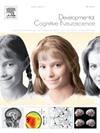Metacontrol instructions lead to adult-like event segmentation in adolescents
IF 4.9
2区 医学
Q1 NEUROSCIENCES
引用次数: 0
Abstract
Event segmentation, which involves dividing continuous information into meaningful units, changes as children develop into adolescents. Adolescents tend to segment events more coarsely than adults. This study explores whether adolescents could adjust their segmentation style to resemble that of adults when provided with explicit metacontrol-related instructions. We compared event segmentation in two adolescent groups and one adult group, while simultaneously recording EEG data. One adolescent group was instructed to perform segmentation as finely as possible, whereas the other adolescent group and adults received no specific instructions on segmentation granularity. EEG data were analyzed using multivariate pattern analysis and source reconstruction. The findings revealed that adolescents given fine-grained instructions adjusted their segmentation probability closer to adult levels, although they did not fully match adults in processing multiple simultaneous changes. Neurophysiological results indicated that adolescents with fine-grained instructions exhibited neural decoding performance more similar to adults. Increased activity in the inferior frontal gyrus in these adolescents compared to adults related to this. The results suggest that adolescents with fine-grained instructions demonstrated more persistent cognitive control and enhanced top-down attention than their peers and adults. The study shows that adolescent cognitive processes can be shifted toward adult-like performance through instructions.
元控制指令会使青少年产生类似成人的事件分割能力。
事件分割涉及到将连续的信息分割成有意义的单位,随着儿童发展到青少年而发生变化。青少年倾向于比成年人更粗略地分割事件。本研究探讨了当提供明确的元控制相关指示时,青少年是否可以调整其分割风格,使其与成人相似。我们比较了两个青少年组和一个成人组的事件分割,同时记录了脑电图数据。一组青少年被要求尽可能精确地进行分割,而另一组青少年和成年人没有收到关于分割粒度的具体指示。采用多变量模式分析和源重构对脑电数据进行分析。研究结果表明,给予细粒度指令的青少年将他们的分割概率调整得更接近成年人的水平,尽管他们在处理多个同时发生的变化时并不完全符合成年人的水平。神经生理学结果表明,接受细粒度指令的青少年表现出与成人更相似的神经解码表现。与成年人相比,这些青少年额下回的活动增加与此有关。结果表明,与同龄人和成年人相比,接受细粒度指令的青少年表现出更持久的认知控制和更强的自上而下的注意力。该研究表明,青少年的认知过程可以通过指导转变为成人的表现。
本文章由计算机程序翻译,如有差异,请以英文原文为准。
求助全文
约1分钟内获得全文
求助全文
来源期刊

Developmental Cognitive Neuroscience
NEUROSCIENCES-
CiteScore
7.60
自引率
10.60%
发文量
124
审稿时长
6-12 weeks
期刊介绍:
The journal publishes theoretical and research papers on cognitive brain development, from infancy through childhood and adolescence and into adulthood. It covers neurocognitive development and neurocognitive processing in both typical and atypical development, including social and affective aspects. Appropriate methodologies for the journal include, but are not limited to, functional neuroimaging (fMRI and MEG), electrophysiology (EEG and ERP), NIRS and transcranial magnetic stimulation, as well as other basic neuroscience approaches using cellular and animal models that directly address cognitive brain development, patient studies, case studies, post-mortem studies and pharmacological studies.
 求助内容:
求助内容: 应助结果提醒方式:
应助结果提醒方式:


